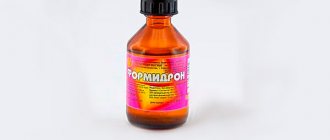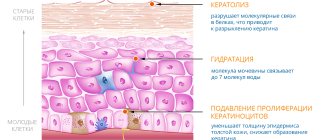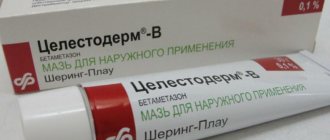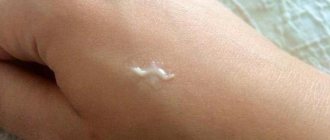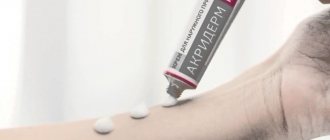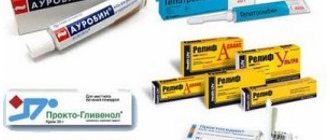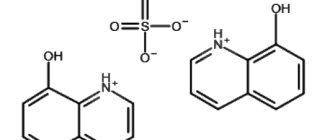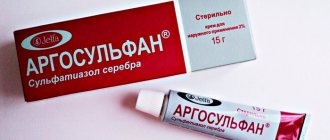Boric ointment has a disinfecting and antifungal effect; it helps in the treatment of head lice, pustular rashes, and otitis media. It is available in the form of 5% of the drug, and if a different concentration is needed, adding salicylic acid, sulfur, naphthalan, zinc, tar, an individual prescription is prescribed.
This external remedy has a low cost (about 30 rubles), but is highly toxic to the body when applied to large surfaces, especially inflamed ones. Therefore, it cannot be used for more than 7-10 days and on large areas of the skin.
Boric ointment is contraindicated for pregnant women, nursing mothers, and children under one year of age, and under 12 years of age it is used with caution and as prescribed by a doctor. The drug is prohibited for kidney disease, as slow elimination leads to poisoning of the body.
Features of the drug
Having the Latin name Boric acid ointment, the drug can be purchased freely in city pharmacies.
An antiseptic and disinfectant, boric ointment has a relatively small number of side effects, which makes it possible to use it even for particularly sensitive skin, which exhibits a negative reaction when using other, more active drugs. By expressing an irritating effect on the skin, the active substances of boric ointment promote tissue regeneration. You do not need a doctor's prescription to purchase it.
Having the ability to penetrate even microcracks and abrasions of the skin, the drug can accumulate in the epidermis with prolonged use of the ointment. Therefore, you should limit the period of use of harrow ointment. Excess active substance is eliminated from the body by the kidneys through urine. A dermatologist should determine the duration of use of this drug for external use, which allows both to avoid possible side effects during use and to speed up the recovery process.
Boric ointment 5 percent (photo)
Dosage forms
Presented in the form of an ointment intended for external use, this drug copes well with most manifestations of inflammation caused by exposure to pathogenic microflora (infectious, bacterial, fungal). The ointment is easy to use, causes rapid regeneration of damaged epidermal cells, eliminating signs of inflammation.
The ointment is applied to damaged parts of the skin and does not require rubbing. This is ensured by a well-balanced composition of the drug, the active substance of which penetrates even through the smallest cracks in the skin. This explains the increased effectiveness of the drug.
The ointment is available for sale in pharmacies. It has a light beige or white color, has a slight medicinal smell, and is quickly absorbed by the skin. When in contact with healthy areas of the skin, it does not have a negative effect. This quality of the drug allows it to be used on large affected areas without fear of negative effects on the remaining parts of the healthy epidermis. The ointment is packaged in aluminum tubes of 15 g and in cardboard boxes. Also, the drug can have a volume of 25 g and be packaged in bottles.
Compound
The active component of the drug is boric acid, which has pronounced drying and antimicrobial properties. An additional substance is purified medical Vaseline, which forms the basis of the ointment and, in parallel with the therapeutic effect, provides active tissue hydration.
Boric ointment prices
The cost of boric ointment is affordable for most of the population. Its price is about 85-125 rubles, depending on the manufacturing company, the volume of packaging of the drug and the trade markup.
Overdose
wheezing, stomatitis, eczema, tissue swelling, menstrual irregularities, anemia, swelling, alopecia. Likuvannya is more symptomatic. Indications include blood transfusion, hemo-peritoneal dialysis. In case of episodic administration of the drug internally, carry out probe rinsing of the tube, including internal salt transfer agents, enterosorbents (activated vugilla), symptomatic therapy. In times of severe isolation from life, go to the extent of supporting the vital functions of the body.
Instructions for use
Instructions for using Boric ointment indicate the only correct way to apply it - externally, locally.
In case of damage to the body, the ointment is applied only to a segment of the dermis pre-treated with an antiseptic. The optimal period is before bedtime. Duration of therapy – from 5 to 10 days
It is important that the layer on the surface of the skin of the drug is thin
Indications and contraindications
Let's take a closer look at what Boric ointment helps with. The antiseptic in question, which is widely used in dermatological practice, is used for the following symptoms and ailments:
Only a doctor can establish an accurate diagnosis, and therefore a preliminary consultation with a dermatologist is a prerequisite for effective treatment.
- severe renal failure in chronic form;
- increased sensitivity to the acid used;
- period of breastfeeding and childbearing;
- children's age up to 1 year.
Before applying the ointment to the damaged area of the dermis, it is important to treat a small segment to ensure that there are no allergic reactions to the medication. Liniment is applied superficially
If it is necessary to get rid of such an unpleasant disease as subcutaneous mites, the ointment is applied to the problem area of the dermis in a thin layer. The frequency of treatment is 2 times a day. Duration of therapy – up to 10 days
Liniment is applied superficially. If it is necessary to get rid of such an unpleasant disease as subcutaneous mites, the ointment is applied to the problem area of the dermis in a thin layer. The frequency of treatment is 2 times a day. Duration of therapy is up to 10 days.
Side effects and special instructions
An ointment based on boric acid is highly tolerated by patients. Side effects are very rare. In most cases, we are talking about fast-passing allergic reactions.
Side effects of the medication:
In case of an overdose, a high concentration of acid accumulates in the blood, which is fraught with problems with the excretory and cardiovascular systems. Some patients experience baldness, inflammation of the skin and mucous membranes.
Description of the drug
The pharmaceutical agent in question, based on boric acid, treats mainly scabies, as well as a number of other skin rashes: demodicosis, lichen, seborrhea, acne and psoriasis. The medicine is often used to smooth out scars, scars and lighten individual segments of the dermis.
Treatment with ointment begins only as prescribed by a dermatologist. The medication is used externally, locally. If the dosage and frequency of treatment are observed, a pronounced therapeutic effect is achieved, pathological processes localized in the epidermis are eliminated.
Clinical and pharmacological group
The medication belongs to the pharmacological group of local antiseptic drugs. In accordance with the international classification, the pharmaceutical product is assigned the ATC code “D08AD”. The medicine is widely used in dermatology.
pharmachologic effect
The 5 percent Bornaya ointment in question is a representative of disinfectants and antiseptics. The medication is often used for various injuries of the body and skin.
Liniment is characterized by multidirectional pharmacological effects:
- antiparasitic;
- antimycotic;
- antibacterial.
The mechanism for suppressing pathogenic microorganisms comes down to coagulation of protein compounds of potentially dangerous microbes. The active component of the ointment specifically affects the cell membrane, increasing their permeability. Liniment ingredients affect granulation tissues.
Boric acid easily penetrates the epithelial layer of the skin and mucous membranes. It is characterized by an accumulation effect, which ensures targeted inhibition of the activity of pathogenic microorganisms.
Release form and composition
White ointment is available in pharmacies in 30 and 25 g aluminum tubes, as well as in glass containers of similar volume. Often we are talking about a 5% product, which implies the concentration of boric acid in the drug in question.
Composition of the medicine, per 1 g of the finished product:
- Vaseline base – up to 950 mg;
- boric acid – about 50 mg.
We are talking about a drug with a minimum amount of ingredients, and therefore boric ointment is easy to make at home. To do this, it is enough to mix the listed components with each other, maintaining a percentage relationship between them.
The Vaseline base of the liniment ensures a prolonged effect of the medication, thereby increasing the therapeutic effectiveness of the drug.
Storage conditions and periods
According to the official instructions and manufacturer's recommendations, it is recommended to store the drug in a place protected from sunlight, at temperatures up to 25 ° C, and relative humidity up to 75%. In sealed packaging, the medicine can be stored for up to 48 months.
pharmachologic effect
The drug in question has a high degree of activity against pathogenic microflora of almost any nature. By eliminating bacterial effects, the active substance of the ointment copes with many external manifestations of the lesion - it relieves tissue inflammation and swelling.
Being an active antiseptic, the drug is prescribed in medical therapy both for the initial stages of dermatological lesions and for large areas of damage. Combining a fungistatic and slight bactericidal effect, the active component of boric ointment slows down the process of reproduction of pathogenic microflora and gradually stops it.
Pharmacodynamics
The basis for the active effect of boric acid is the ability of its cells to penetrate the membrane tissues of pathogenic microflora cells, which reduces the process of formation of proteins necessary for active division.
Accompanied by the elimination of inflammatory processes in the affected parts of the epidermis, the regenerative functions, when regularly applied to the affected skin, ensure the most improved recovery. In addition to skin cells, the active substance of the drug in question quickly penetrates the systemic bloodstream, granulation tissues and mucous membranes, which also contributes to a faster positive effect. Boric acid has an increased ability to penetrate almost all tissues and fluids of the body, which imposes certain requirements for its use: it is not recommended to use boric ointment during pregnancy due to the penetration of the active substance through the placental barrier.
Pharmacokinetics
The breakdown products of the drug are excreted by the kidneys through urine and partially by bile. The cumulative ability of boric acid requires limiting the time of its use - its particles accumulate in the treated skin. Complete elimination of this drug from the body occurs within 7-10 days from the end of its use.
Active ingredient and composition
The active ingredient is boric acid - it belongs to weak orthoboric acids. A slightly opalescent transparent ointment with a specific odor is represented by the following composition:
- the active ingredient is boric acid (5%);
- excipient – Vaseline (to give the ointment the desired thick consistency and for convenient application of the product).
A type of boric ointment
Boric ointment comes in several types, different in composition:
- Boric tar ointment - in addition to boric acid and petroleum jelly, the product contains birch tar.
- Boron-zinc-naphthalan ointment - with the addition of naphthalan ointment and zinc.
Boric ointment instructions for use
Latin name: boric acid ointment ATC code: D08AD Active ingredient: boric acid Manufacturer: Yaroslavl Pharmaceutical Factory, JSC, Russia
Dispensed from the pharmacy: Without a prescription
Storage conditions: darkness Shelf life: 4 years.
Boric ointment has a fairly wide range of applications, mainly in the dermatological field.
Indications for use
What is the product used for:
- To combat pediculosis and the spread of lice
- Dermatitis, eczema, neurodermatitis
- Diaper rash, pyoderma
- In the form of a tincture in the gynecological field for colpitis and for contraception.
Composition and release forms
100 grams of ointment contains 5 grams of active ingredient and 95 grams of medical Vaseline. That is, the ointment is five percent, and the remaining auxiliary components are absent.
The product is sold in aluminum tubes or plastic jars with a capacity of 25 or 15 grams. Boric ointment has a slight specific odor, the color of the substance is uniform from white to yellowish.
Medicinal properties
Boric ointment has bacteriostatic and fungistatic properties. This means that the medication stops the growth and development of pathogenic microorganisms and fungi, but does not destroy them.
Since it is an antiseptic, it disinfects well. The mechanism of action of the drug is based on a high degree of coagulation of foreign protein structures, enzymatic proteins.
From the ointment, boric acid penetrates into the skin structure through microcracks on the body, and the accumulation of the active component occurs in the tissues of the human body. The drug is completely excreted by the kidneys along with urine after a week. This remedy is good for treating neurodermatitis and other skin lesions.
Mode of application
The average cost of medicine in Russia is 50 rubles per package.
Depending on the length, volume and thickness of the hair, on average, from 10 grams to 25 grams of ointment is applied to the hairy areas. After thorough application, it is recommended to keep the product on your head for half an hour, then it is washed off well in warm running water. After rinsing, the hair is combed out.
During pregnancy and breastfeeding
During pregnancy and while breastfeeding, the use of the medication is prohibited.
Contraindications and precautions
Contraindications include:
- Inflammatory lesions at the site of application
- Individual intolerance or hypersensitivity to medicinal petroleum jelly or boric acid
- Problems with the urinary system
- Pregnancy and breastfeeding in a woman’s life
- Children under 12 months of age.
Do not allow the drug to get into your eyes! If such an incident occurs, the eyes are immediately washed under cold running water.
Cross-drug interactions
Do not combine use with other external remedies for head lice, as there are no studied interactions, which means the reaction is unknown.
Side effects and overdose
If the drug is used for too long, persistent systemic penetration into the bloodstream through the outer layers of the skin occurs, which in the long term is fraught with the following consequences:
- From the heart and blood vessels: cardiac arrhythmia, hypotension
- Skin: the occurrence of neurodermatitis, redness, stomatitis and eczema
- Effect on the central nervous system: coma or shock, inhibition of reactions
- Genitourinary system: chronic renal or liver failure may occur
- Other: dysmenorrhea, menstrual irregularities and alopecia.
In case of persistent poisoning, a general disruption of the body's functions develops: vomiting and nausea, rashes, urticaria, diarrhea, impaired consciousness, migraine, seizures, kidney failure, coma or shock. Treatment is blood transfusion or dialysis.
Teymurova paste
Central European Pharmaceutical Company, Russia
The average price is 38 rubles per tube.
Teymur paste is used for various skin diseases.
Pros:
- Stronger composition
- It's inexpensive.
Minuses:
- Not suitable for everyone
- Doesn't always help.
Fukortsin
Moscow Pharmaceutical Factory, Russia
The average price is 38 rubles per package.
Fukortsin is one of the trade names of boric acid.
Pros:
- Efficiency
- Wide range of purposes.
Minuses:
- Penetrates the blood
- Leaves bright marks on the skin.
Directions for use and dosage Boric ointment 5% 5% 25g
Apply 10 - 15 - 25 g of ointment to the scalp, then wash off with water after 30 minutes.
The average cost of medicine in Russia is 50 rubles per package.
Depending on the length, volume and thickness of the hair, on average, from 10 grams to 25 grams of ointment is applied to the hairy areas. After thorough application, it is recommended to keep the product on your head for half an hour, then it is washed off well in warm running water. After rinsing, the hair is combed out.
During pregnancy and breastfeeding
During pregnancy and while breastfeeding, the use of the medication is prohibited.
The drug is intended for external use only. To avoid negative consequences, watch out for accidental ingestion of the ointment into the body.
The dosage and course of treatment are selected and established by the doctor.
- For eye infections, the product is placed in the lower conjunctival sac.
- For otitis media, as a maintenance therapy - into the auricle or canal.
- For lice on the scalp, rub 25 g of ointment into the infected area of the body, carefully distributing the product. After half an hour, rinse thoroughly with water and comb with a wide-toothed comb.
- For eczema and dermatitis, apply pharmaceutical ointment to areas with a rash in a dosage of no more than 15 g. After 30 minutes, remove any remaining medicinal substance.
- For wounds that occupy most of the body, apply the ointment to areas that are undamaged and not subject to infection. Apply a thin layer so as not to touch the infected areas.
Boric ointment is used externally. In cases of head lice, apply 10-25 g of the product once to the scalp, leave for half an hour, then rinse with warm water and thoroughly comb the hair with a comb. The dosage of the product for cracks and diaper rash is 10 g, which is applied in a thin layer to the damaged areas.
In cases of inflammatory diseases of the external auditory canal, a small amount of medication is applied to the turunda, which is then injected three times a day into the ear canal.
https://www.youtube.com/watch?v=https:www.googleadservices.compageadaclk
Externally, as an anti-pediculosis agent for lice on the scalp - 10-15-25 g. After 20-30 minutes, rinse and comb out thoroughly.
Externally.
For pediculosis, the product is applied to the scalp, the exact amount depends on the length and thickness of the hair, the degree of lice damage, but usually 10-25 grams is enough. After 30 minutes, rinse it off with warm water, wash your hair with shampoo or soap, and then carefully comb your hair with a comb with small and frequent teeth.
For conjunctivitis, the ointment is placed behind the lower eyelid, for otitis - in the ear canal.
Analogues of Boric ointment
According to their belonging to the same pharmacological group and mechanism of action, analogues of Boric ointment are Boric acid in powder form and in the form of 2% and 3% alcohol solution, as well as Boric acid solution in glycerin 10%.
Popular articles
Read more articles
02.12.2013
We all walk a lot during the day. Even if we have a sedentary lifestyle, we still walk - after all, we...
604371
65
More details
10.10.2013
Fifty years for the fair sex is a kind of milestone, crossing which every second...
443838
117
More details
Self-medication can be harmful to your health.
You should consult your doctor and read the instructions before use.
Analogs
There is a wide range of medications on sale with similar ingredients and mechanisms of action.
The closest analogues of Boric ointment:
- "Otoslavin";
- "Sodium tetraborate";
- “Boric acid based on 10% glycerol”;
- "Boric acid".
The decision to replace the drug is made not by the patient, but by the doctor, based on the nature of the disease, the presence of concomitant complications and contraindications in the patient. Independent use of pharmaceuticals is fraught with aggravation of the pathological process.
Pharmacological properties and indications for use
In addition to the main, antiseptic, Boric ointment also has insecticidal properties, including anti-pediculosis, since boric acid, coagulating the proteins of the microbial cell, disrupts the permeability of its membrane. Therefore, Boric ointment is used primarily as an anti-pediculosis agent. But also, as prescribed by a doctor, it is used to treat eczema, diaper rash, pyoderma, dermatitis, otitis media, conjunctivitis and gynecological diseases (in particular colpitis). In combination with hydroxyquinoline sulfate, it is used as a contraceptive.
Zinc-boron-naphthalan ointment, in addition to boric acid, contains naphthalan ointment and zinc oxide as active components. It is used as an analgesic and antiseptic for neuralgia and myositis, as well as for the treatment of atopic dermatitis, furunculosis, pyoderma, skin diaper rash, limited neurodermatitis, erysipelas of the skin. In these cases, boric acid in the composition of the drug has a disinfecting effect, zinc oxide has an astringent and drying effect, naphthalan ointment has an analgesic, softening, anti-inflammatory and absorbable effect.
Boric-zinc ointment consists of boric acid, zinc oxide and sunflower oil. It has an antiseptic and good drying (thanks to zinc) effect. Designed to treat a wide variety of skin diseases.
Boric tar ointment, in addition to boric acid, contains birch tar. Intended for the treatment of dermatological diseases, in particular eczema, neurodermatitis, fungal skin diseases, pyoderma, psoriasis, seborrhea, scabies, various eczemas (outside the period of exacerbation). It is also used for violations of keratinization processes.
Variants of boric acid ointment, what they help with
Boric acid in a 5% ointment helps treat head lice and get rid of pubic lice. Due to toxicity, it is used much less frequently for:
- pustular rash;
- diaper rash;
- skin cracks;
- inflammation of the skin (dermatitis);
- eczema with the addition of a microbial infection;
- otitis (inflammation of the middle ear);
- colpitis of fungal origin (vaginal thrush).
Boron-zinc-naphthalan
Boric acid in the composition of boron-zinc-naphthalan paste has an antiseptic effect, zinc dries and increases the strength of the skin, and naphthalan softens, resolves, relieves inflammation, swelling and itching, and anesthetizes. This remedy accelerates wound healing and restoration of affected areas.
The drug is used for:
- microbial eczema;
- dermatitis;
- difficult-to-heal wounds;
- bedsores;
- skin cracks;
- neurodermatitis;
- allergic, atopic and seborrheic dermatitis;
- psoriasis, if the rash has a weeping surface;
- trophic ulcers;
- chronic (recurrent) lichen;
- pustular rash (pyoderma);
- erysipelas;
- diaper rash and skin irritation.
The drug is applied in a thin layer 2-3 times a day for no more than 10 days.
Boron-salicylic
In its finished form, boron-salicylic ointment is not supplied to pharmacies; it is prepared according to an individual recipe or mixed in the recommended proportion of 2% salicylic ointment and 5% boric ointment.
This combination is used only in very limited areas, since salicylic acid promotes deeper penetration of boric acid and its accelerated entry into the blood. A combination of two acids in an ointment is prescribed for:
- pyoderma (skin inflammation and rash of staphylococcal or streptococcal origin);
- diaper rash;
- acne;
- chronic eczema;
- seborrheic dermatitis with increased oily skin.
The ointment is applied to the affected area 2-3 times a day, treatment lasts no more than 1.5 weeks.
Boric-tar
Boron-tar ointment is prepared only individually, according to a prescription from a dermatologist.
Adding tar to boric acid enhances its antiseptic, antiparasitic and drying effects. This combination also reduces itching, redness and swelling of the skin, relieves pain, and resolves areas of compaction. The ointment is indicated for:
- psoriasis (beyond the acute stage);
- seborrheic and microbial eczema;
- neurodermatitis (after the main course of therapy);
- skin itching due to skin irritation.
Usually used before bed for 7 days, it is important to apply carefully to the face to avoid getting the product into the eyes.
Sulfur-boron
Sulfur-boron ointment is prescribed for the treatment of scabies in the presence of a secondary infection due to scratching of the skin; this combination can also be recommended for seborrheic dermatitis. The affected area is treated for no more than 5 days. The drug does not come in ready-made form; to prepare it in a pharmacy you will need a prescription from a dermatologist.
Boric ointment instructions for use, indications
Surely everyone has heard of such a drug as boric ointment. Instructions for use of this product, its properties, adverse reactions and indications will be described below.
Packaging and composition of the local product
In what packaging is boric ointment sold? Instructions for use of this drug are included in a cardboard box. It also contains an aluminum tube with a medicinal substance or a dark glass jar.
The composition of the medication in question includes boric acid, as well as regular petroleum jelly.
Properties of the local drug
Boric ointment, the instructions for which are presented below, is an antiseptic drug that is actively used in dermatological practice. This product exhibits antifungal, antibacterial and antiparasitic properties.
Treatment with this ointment is permissible only with the permission of the doctor. The main component of this medicine is boric acid. It is contained in the preparation in an amount of 5%. As for the rest of the medication, it is ordinary Vaseline.
What properties does boric ointment have? The instructions for use indicate that this drug is intended to destroy parasites, fungi and bacteria. This is an antiseptic that has mild fungistatic and bacteriostatic properties. In addition, it has an anti-pediculosis effect.
When this drug is combined with hydroxyquinoline sulfate, it exhibits a contraceptive effect.
Boric ointment easily penetrates into the blood through injuries such as wounds and microcracks, as well as mucous membranes and skin. In this case, the medication accumulates in the tissues and leaves the body along with urine a week after the last application.
Indications for use of external ointment
When do patients use boric ointment? Instructions for use (this remedy helps very well with psoriasis) states that this drug is often prescribed for:
- diseases of the visual organs, including conjunctivitis;
- parasitic diseases, including pediculosis;
- skin diseases, including dermatitis, various types of eczema, diaper rash, pyoderma and others;
- gynecological diseases (for example, colpitis);
- diseases of the ENT organs, including otitis media.
It should also be said that the medication in question, together with hydroxyquinoline sulfate, is often used for contraception.
Contraindications to the use of ointment
In what cases is boric ointment not used? Instructions for use (for eczema, this remedy should only be prescribed by a doctor) informs that the medication in question is not recommended for people with personal intolerance to its components. In addition, chronic renal failure is a contraindication for this medicine.
This medication should not be used in the presence of inflammatory skin diseases that are in the acute stage. This drug is also contraindicated for babies under one year of age and pregnant women.
When breastfeeding, ointment should not be applied to the nipples.
If a person has damaged large areas of the body, then the drug in question is applied to them extremely carefully, bypassing the areas of damage
Boric ointment: instructions for use
This drug can only be used externally. Its dosage and frequency of use are prescribed by the doctor, depending on the stage and type of the disease. As a rule, to treat conjunctivitis, this remedy is injected into the conjunctival area, and otitis - into the ear canals.
If dermatitis is detected, this medication should be used only in areas where the rash appears. To treat head lice, boric ointment is applied to the head in a dosage of 10-30 g, then kept for half an hour and then washed off with warm water.
Having carried out this procedure, comb the hair well with a comb-comb.
Adverse reactions after application
When using this drug, patients may experience negative effects such as:
- dyspeptic manifestations: diarrhea, nausea and vomiting;
- headache;
- rashes on the integument;
- desquamation of the epithelial layer;
- state of shock;
- decreased daily urine output;
- confusion.
With prolonged use of the ointment or its absorption into the blood through existing wounds and cracks, undesirable reactions are possible, such as:
- excretory system: renal failure of chronic or acute type;
- heart and blood vessels: arrhythmia and decreased blood pressure;
- menstrual irregularities;
- nervous system: lethargy, shock, fever, coma;
- baldness;
- inflammation of the skin and mucous membranes (including stomatitis, eczema and erythema).
Reviews
Tatyana, Yekaterinburg
I can confirm with 100% confidence that 5% Boric ointment really removes age spots on the skin. I used this product to get rid of post-acne, and the result was also impressive. Before this, I treated my skin with Metrogyl ointment, but it turned out to be completely useless. I would never have thought that for such little money you could buy a truly effective drug.
Read further:
Boromenthol ointment: instructions for use, review and reviews
Betamethasone ointment: instructions for use, review and reviews
We see the ointment: instructions for use, review and reviews
Ben Gay ointment (cream): instructions for use, review and reviews
Vipratox ointment: instructions for use, prescription, review of analogues and patient reviews
Boric ointment (review) from 30 rubles
Overall
4.8
- Efficiency
- Price
- Safety
- Availability
Pros
- Efficiency
- Price
Cons
Side effects
Side effects when using boric ointment can be:
- strengthening of existing manifestations of the current disease;
- the appearance of increased sensitivity of the skin;
- skin hyperemia at the sites of ointment application, erythema.
Due to prolonged use of BM, the following effects may appear:
- from the cardiovascular system - arrhythmia, decreased blood pressure,
- from the nervous system - lethargy and increased body temperature,
Extremely rare, but acute or chronic renal failure occurred in patients. Also, side effects when using this drug may include nausea, dizziness, and tissue swelling. In these cases, the use of the drug should be discontinued.
Adverse reactions after application
The instructions for Boric ointment indicate its main pharmacological properties aimed at destroying parasites, bacteria and fungi.
Boric ointment is able to penetrate through damage (wounds, microcracks) of the skin and mucous membrane into the blood. The drug accumulates in tissues and is excreted in the urine five to seven days after the last use.
When using Boric ointment, the following side effects may occur:
- dyspeptic manifestations: nausea, diarrhea, vomiting;
- skin rashes;
- headache;
- desquamation of the epithelial layer;
- decrease in daily urine output;
- state of shock;
- confusion.
With prolonged treatment with ointment or absorption into the blood through wounds, the following symptoms are possible:
- from the cardiovascular system: decreased blood pressure and arrhythmia;
- from the excretory system: renal failure of acute or chronic type;
- from the nervous system: increased body temperature, lethargy, coma, shock;
- baldness;
- menstrual irregularities;
- inflammation of the mucous membranes and skin (stomatitis, erythema and eczema).
Antiseptic. It has weak bacteriostatic and fungistatic properties and has an anti-pediculosis effect.
In combination with hydroxyquinoline sulfate, it has contraceptive properties.
When using this drug, patients may experience negative effects such as:
- dyspeptic manifestations: diarrhea, nausea and vomiting;
- headache;
- rashes on the integument;
- desquamation of the epithelial layer;
- state of shock;
- decreased daily urine output;
- confusion.
https://www.youtube.com/watch?v=ytcopyrightru
With prolonged use of the ointment or its absorption into the blood through existing wounds and cracks, undesirable reactions are possible, such as:
- excretory system: renal failure of chronic or acute type;
- heart and blood vessels: arrhythmia and decreased blood pressure;
- menstrual irregularities;
- nervous system: lethargy, shock, fever, coma;
- baldness;
- inflammation of the skin and mucous membranes (including stomatitis, eczema and erythema).
If the drug is used for too long, persistent systemic penetration into the bloodstream through the outer layers of the skin occurs, which in the long term is fraught with the following consequences:
- From the heart and blood vessels: cardiac arrhythmia, hypotension
- Skin: the occurrence of neurodermatitis, redness, stomatitis and eczema
- Effect on the central nervous system: coma or shock, inhibition of reactions
- Genitourinary system: chronic renal or liver failure may occur
- Other: dysmenorrhea, menstrual irregularities and alopecia.
In case of persistent poisoning, a general disruption of the body's functions develops: vomiting and nausea, rashes, urticaria, diarrhea, impaired consciousness, migraine, seizures, kidney failure, coma or shock. Treatment is blood transfusion or dialysis.
Side effects are caused by the active component entering the bloodstream.
- Decrease in blood pressure with the development of arrhythmia;
- From the neurological side, inhibition in actions may appear. In extremely rare cases: state of deep sleep - coma;
- increased risk of developing kidney failure;
- menstrual irregularities;
- alopecia;
- epidermal diseases: eczema, ;
- disorders of the gastrointestinal tract (nausea, vomiting, diarrhea);
- increased body temperature to the point of shock;
- convulsions;
- desquamation of epithelial cells.
Using the drug in excessive doses and for other purposes can lead to serious consequences.
This condition is characterized by symptoms of intoxication of the body:
- rash;
- nausea;
- vomit;
- confusion of coordination;
- severe headache and dizziness;
- a state of shock or even a coma is possible.
According to reviews, the drug in some cases causes impaired renal function, skin rash, headache, diarrhea, convulsions, desquamation of the epithelium, confusion, nausea and vomiting.
According to numerous reviews, this drug rarely causes side effects when the dosage is observed. However, it should be borne in mind that in individual cases skin rashes are possible.
When using Boric ointment in large quantities and for a long period of time, signs of intoxication may occur - nausea, vomiting and diarrhea. Some patients complain of headaches, cramps and kidney problems.
In some cases, women experience menstrual irregularities, and men experience baldness.
If Boric acid accidentally gets into the blood, disorders may occur in the functioning of the cardiovascular system (for example, low blood pressure, arrhythmia), in the functioning of the nervous system (fever, shock, general lethargy, coma), in the functioning of the excretory system (most often the renal failure).
https://www.youtube.com/watch?v=https:accounts.google.comServiceLogin
Therefore, if the patient accidentally ingested the drug, he should immediately perform a gastric lavage, take a saline laxative and enterosorbent (for example, activated charcoal) orally, and carry out symptomatic therapy. In case of severe poisoning, measures are taken to maintain the vital functions of the body in a hospital setting.
Medicinal properties
Boric ointment has bacteriostatic and fungistatic properties. This means that the medication stops the growth and development of pathogenic microorganisms and fungi, but does not destroy them. Since it is an antiseptic, it disinfects well. The mechanism of action of the drug is based on a high degree of coagulation of foreign protein structures, enzymatic proteins. The medicine also disrupts the membrane of the cellular structure of bacteria, irritates mucous membranes and granular tissues.
From the ointment, boric acid penetrates into the skin structure through microcracks on the body, and the accumulation of the active component occurs in the tissues of the human body. The drug is completely excreted by the kidneys along with urine after a week. This remedy is good for treating neurodermatitis and other skin lesions.
Features of stastosuvannya
“Bornu ointment 5%” should not be applied to hairy areas in case of acute inflammation of the skin. Be sure to avoid spilling the ointment into your eyes (whenever spilled, rinse your eyes with warm water). Do not apply to large areas of the body.
In case of individual intolerance to boric acid or other components of the drug, it is recommended to take a medicinal dose.
Suspension during pregnancy or breastfeeding.
During pregnancy or pregnancy, breastfeeding is contraindicated.
This is due to the fluidity of the reaction during treatment with vehicles or other mechanisms.
The drug does not reach the site of ceruvate via transport or other mechanisms.
For pediculosis, boron ointment is applied to the scalp gradually depending on the level of infection, thickness and length of the hair, for 10–15–25 g. After 20–30 minutes, wash off with warm running water to prevent any other substances from condensing. Hair should be carefully combed with a thick comb.
Stagnation in case of inflammation of the external auditory canal is prescribed by a doctor and depends on the nature of the pathological process.
For flat or cracked skin, apply the ointment with a thin ball onto the area.
Evidence of stagnation in children every day.
Instructions for use
The use of the drug in question is based on applying it to the previously cleaned surface of the affected skin. The ointment is applied to the skin using gentle rubbing movements and left to work. Quickly absorbed into the skin, it does not leave greasy marks on it and does not stain clothes.
Depending on the age, both the dosage used for treatment and the duration of exposure to the drug are determined. Special instructions should be taken into account when carrying a child and the lactation period, so as not to harm the baby and the pregnant woman.
You can prepare boric ointment by thoroughly mixing boric acid and petroleum jelly. The resulting mixture should be stored in the refrigerator, away from direct sunlight.
For adults
Use by adults involves applying it to the affected areas, if indicated, once a day; after application, it is preferable not to cover the treated areas with clothing for better absorption of the active substance by the skin. The duration of exposure is determined by the attending dermatologist; for adults it is 5-9 days without a break.
Children and newborns
- During the newborn period,
the use of boric ointment is not indicated due to the increased sensitivity of children's skin and the high likelihood of allergic reactions. - For children,
the ointment can be prescribed for no more than 5 days, subject to constant monitoring by a doctor. The ointment is applied to damaged areas 1-2 times a day; rubbing it into the skin is not required.
During pregnancy and lactation
- Pregnancy
. Since the active substance of the drug tends to penetrate the placental barrier, its use during pregnancy is not recommended to prevent the occurrence of negative reactions from the body of both the expectant mother and the baby. - During lactation,
if the benefits obtained prevail over the possible side effects, boric ointment can be prescribed, but its use requires increased attention to the condition of the child and the woman.


